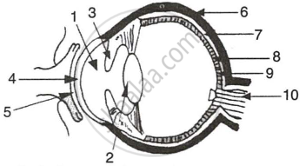Advertisements
Advertisements
प्रश्न
Nocturnal animals (animals which sleep during the day and come out at night) tend to have wide pupils and lot of rods in their retinas. Suggest reasons for this.
उत्तर
Nocturnal animals, such as owls, tend to have wide pupils and several rod cells in their retina because wide pupil allow more light to enter the eyes and the rods cells in the retina are sensitive to dim light and are vital for night vision.
APPEARS IN
संबंधित प्रश्न
Give the scientific names of the following parts of the eye:
a hole in the middle of the iris.
After testing the eyes of a child, the optician has prescribed the following lenses for his spectacles:
Left eye : + 2.00 D
Right eye : + 2.25 D
The child is suffering from the defect of vision called:
(a) short-sightedness
(b) long-sightedness
(c) cataract
(d) presbyopia
Five persons A, B, C, D and E have diabetes, leukaemia, asthma, meningitis and hepatitis, respectively.
Which of these persons can donate eyes?
Name the following:
The photoreceptors found in the retina of the eye.
Name the following:
The pigmented circular area seen in the eye.
State the Location of:
Lacrimal gland
Match the following:
| Column - I | Column - II | ||
| 1 | Retina | a | Path way of light |
| 2 | Pupil | b | Far point comes closer |
| 3 | Ciliary muscles | c | near point moves away |
| 4 | Myopia | d | Screen of the eye |
| 5 | Hypermetropoia | e | Power of accomodation |
Match the following:
| Column - I | Column - II |
| 1. Retina | a. Path way of light |
| 2. Pupil | b. Far point comes closer |
| 3. Ciliary muscles | c. near point moves away |
| 4. Myopia | d. Screen of the eye |
| 5. Hypermetropia | e. Power of accommodation |
With reference to human eye answer the question that follow:
Name the part of the eye associated with keeping the lens moist and protecting it from physical shock.
The figure given below refers to the vertical section of the eye of a mammal. Study the figure carefully and answer the following questions.
 |
- Label the guidelines shown as 1 to 10.
- Write one important role of parts shown as 3 and 7.
- Write one structural difference between the parts shown as 9 and 10.
- Mention one functional difference between the parts shown as 6 and 8.
